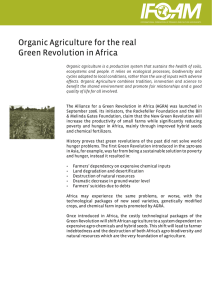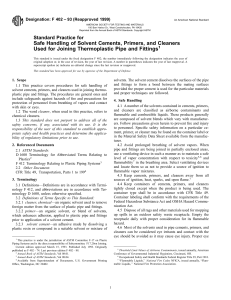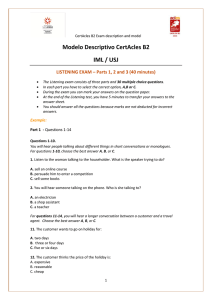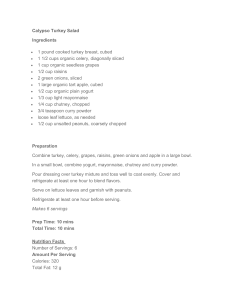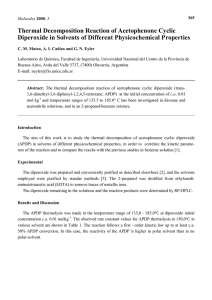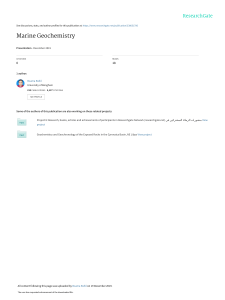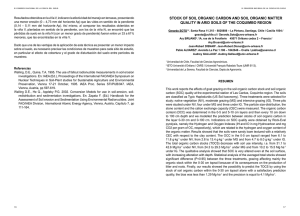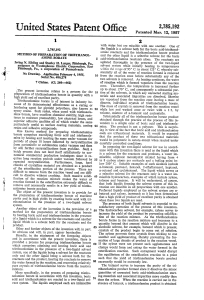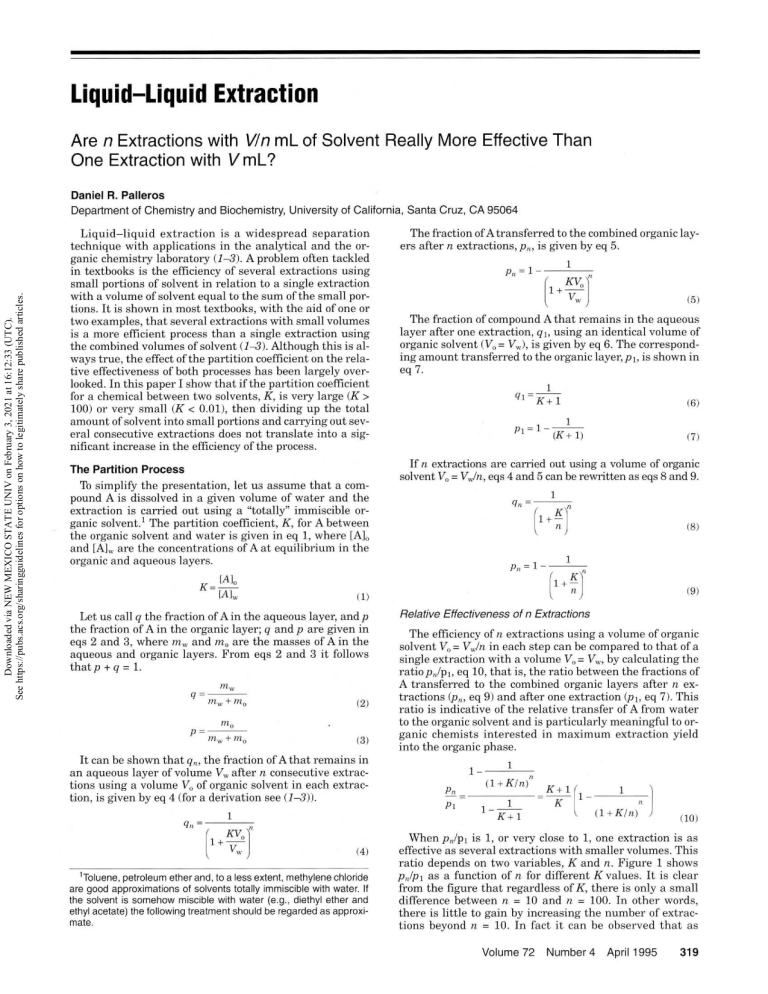
Liquid-Liquid Extraction Are n Extractions with V/n mL of Solvent Really More Effective Than One Extraction with V mL? Downloaded via NEW MEXICO STATE UNIV on February 3, 2021 at 16:12:33 (UTC). See https://pubs.acs.org/sharingguidelines for options on how to legitimately share published articles. Daniel R. Palleros Department of Chemistry and Biochemistry, University of California, Santa Cruz, CA 95064 Liquid—liquid extraction is a widespread separation technique with applications in the analytical and the organic chemistry laboratory (1-3). A problem often tackled in textbooks is the efficiency of several extractions using small portions of solvent in relation to a single extraction with a volume of solvent equal to the sum of the small portions. It is shown in most textbooks, with the aid of one or two examples, that several extractions with small volumes is a more efficient process than a single extraction using the combined volumes of solvent (1-3). Although this is always true, the effect of the partition coefficient on the relative effectiveness of both processes has been largely overlooked. In this paper I show that if the partition coefficient for a chemical between two solvents, K, is very large (K > 100) or very small (K < 0.01), then dividing up the total amount of solvent into small portions and carrying out several consecutive extractions does not translate into a significant increase in the efficiency of the process. The Partition Process To simplify the presentation, let us assume that a com- The fraction of A transferred to the combined organic layafter n extractions, p„, is given by eq 5. ers Pn - (2) P KV, (5) The fraction of compound A that remains in the aqueous layer after one extraction, qi, using an identical volume of organic solvent (V0 Vw), is given by eq 6. The corresponding amount transferred to the organic layer, plt is shown in = eq 7. Qi K+ Pi = 1 (6) 1 ' (tf+i) (7) If ti extractions are carried out using a volume of organic solvent V0 = VJn, eqs 4 and 5 can be rewritten as eqs 8 and 9. Qn ' 1 + K (8) 19) (1) Let us call q the fraction of A in the aqueous layer, and p the fraction of A in the organic layer; q and p are given in eqs 2 and 3, where mw and m0 are the masses of A in the aqueous and organic layers. From eqs 2 and 3 it follows that p + q = 1. q +- 1 pound A is dissolved in a given volume of water and the extraction is carried out using a “totally” immiscible organic solvent.1 The partition coefficient, K, for A between the organic solvent and water is given in eq 1, where [A]0 and [A]w are the concentrations of A at equilibrium in the organic and aqueous layers. MJW l = = (3) can be shown that qn, the fraction of A that remains in aqueous layer of volume Vw after n consecutive extractions using a volume Va of organic solvent in each extraction, is given by eq 4 (for a derivation see (1-3)). Relative Effectiveness of n Extractions The efficiency of n extractions using a volume of organic solvent V,, VJn in each step can be compared to that of a single extraction with a volume V0 = Vw, by calculating the ratiop„./pi, eq 10, that is, the ratio between the fractions of A transferred to the combined organic layers after n extractions (p„, eq 9) and after one extraction (pu eq 7). This ratio is indicative of the relative transfer of A from water to the organic solvent and is particularly meaningful to organic chemists interested in maximum extraction yield into the organic phase. = It an (1 + Kln)n Pn, Pi 1 - K K + K 1 + 1 1 f 1 (1 +K!n) Qn 1 + KVn - (4) ’Toluene, petroleum ether and, to a less extent, methylene chloride good approximations of solvents totally immiscible with water. If the solvent is somehow miscible with water (e.g., diethyl ether and ethyl acetate) the following treatment should be regarded as approxiare mate. (10) When p„/pi is 1, or very close to 1, one extraction is as effective as several extractions with smaller volumes. This ratio depends on two variables, K and n. Figure 1 shows pjpi as a function of n for different. K values. It is clear from the figure that regardless of K, there is only a small 10 and n = 100. In other words, difference between n there is little to gain by increasing the number of extractions beyond n 10. In fact it can be observed that as = = Volume 72 Number 4 April 1995 319 Figure 1. Ratio between the tractions transferred to the organic layer after n extractions with V0 = VJn mL of solvent and after one extraction with V0 = l/w mL of solvent as a function of the number of extractions for the K values indicated on each line in the figure. \/0 is the volume of organic solvent; l/w is the volume of aqueous phase. Figure 2. Ratio between the fractions transferred to the organic layer after n = 1,2, 5,10, and », extractions with V0 VJn mL of solvent and after one extraction with V0 = Vw mL of solvent as a function of the partition coefficient. Inset: The same ratio is shown for n 2 and « n for a wider K range. a limit that depends on K. It can that the limit forpjpiasn->« is given by eq 11.2 This limit equals 1.297 for K 2, but for K 0.01 and K 100 the limit is only 1.005 and 1.010. Complete Removal of A n —> <*>, p,Jp\ converges to be demonstrated = = = K+ K 1 (11) = When we are interested in the complete removal of A from the aqueous layer (for example, in the analytical chemistry lab, when the removal of traces of interferences from the aqueous layer is crucial for the success of subsequent analyses) the fraction to consider is qn, eq 8, that is, the fraction of A that remains in the aqueous layer after n extractions. As n —> q„ e~h. It follows that there is a limit, which depends on K, to the amount of A that can be extracted from the aqueous phase by increasing the number of steps and decreasing accordingly the volume of organic solvent. For example, to extract 99.99% of A from the aqueous layer, q = 0.0001, K must be larger than 9.2; for K < 9.2 it is not possible to obtain a 99.99% removal from the aqueous phase even if n —> °=.3 From the point of view of the removal of chemicals from the aqueous phase, a parameter that better represents the relative effectiveness of n extractions as compared to one is q„/q i, that is, the ratio between the fractions of A remaining in the aqueous layer after n extractions and after one extraction, eq 12. = Solutes with Very Low or Very High Affinity Figure 2 shows p,Jpi as a function of K for several n valincluding the limiting case when n —> «>. In all cases (n * 1) the ratio is greater than 1 and reaches a maximum around K 2; however, if the partition coefficient is very low (K < 0.01) or high (K> 100) the ratio pjp\ is close to 1 regardless of n. This means that for a solute with very low affinity for the organic solvent (K < 0.01) one extraction with a volume V of organic solvent is almost as ineffective as 2, 3, 4, n, using a volume equal to V/n each time; the solute will remain mainly in the aqueous layer. On the other hand, if the solute has a very large affinity for the organic solvent (K > 100), one extraction with a volume V of organic solvent would transfer almost as much as n extractions with V/n because most of the solute will go to the organic solvent in the first extraction. The figure shows that several extractions with small volumes of solvent are significantly more advantageous than one extraction with a large volume only for intermediate values of the partition coefficient (K 0.05-20). .Using general principles of function analysis it can be shown that the maximum forp„/p! occurs at K= 1.793,1.937, and 2.000 for ues = ... = n —> w, = 3, and 2. <? = ea. See, for example, reference 4. (12) A plot of q„/qi as a function of the number of extractions for several K values is shown in Figure 3. It can be observed that this ratio also reaches a limit as n —> this limit depends on K as indicated in eq 13. n—*°° 3Students may find it very interesting that the factor that sets the limits in the liquid-liquid extraction processes discussed here, that is, (1 +(a/n))n where a is the partition coefficient, also appears in the equation of compounded interest. It can be shown that the amount of money accrued after (years, A, on a principal P invested at an annual interest rate rand compounded n times per year is A = P(1 +(r/ri))n’. Perhaps contrary 1o intuition, there is an absolute ceiling to the amounl accrued after (years, no matter how often the interest is compounded during the year; when the interest is compounded continuthe amount accrued after (years is A Pen\ for ously, that is, n -> a detailed discussion of the subject the reader is referred to ref 4. °° 320 Journal of Chemical Education = 1 l lira— 2lim (1 + (a/n))n K+ to, = (K + l)e~K *41 (13) For small partition coefficients, q„/q i is close to 1, regardless of the number of extractions. This shows, again, that there is little to gain by dividing up the volume of the extracting solvent when the partition coefficient is too small. It can also be observed that for K > 100, there is a substantial difference between one and two extractions, but the ratio falls rapidly to zero thereafter. Thus, for large values of K, the removal of A from the aqueous phase can be done effectively with two extractions using V/2 mL of organic solvent; increasing the number of extractions after n = 2 has only a very limited effect on the effectiveness of the process. These facts indicate that the removal of a chemical from the aqueous phase can be substantially improved by dividing up the volume of the extracting solvent and increasing the number of extractions only for intermediate values of the partition coefficient. Acknowledgment I am grateful to Keith Oberg, University of California, Santa Cruz for critical reading of the manuscript. Literature Cited 1. Figure 3. Ratio between the fractions remaining in the aqueous layer after n extractions with Va VJn ml of organic solvent and after one extraction with V0 = Vw mL of solvent as a function of the number of extractions for the K values indicated in the figure. = Furniss, B. S.; Hannaford, A. J.; Smith, P. W. S.; Tatchell, A. R. Vogel’s Textbook of Practical Organic Chemistry, 5th ed.; Longman. New York, 1989; pp 158-160, 2. Skoog, D. A.; West, D. M. Analytical Chemistry, 4th ed.; Saunders: Philadelphia, 1986; pp 484-486. 3. Kennedy, J. H. Analytical Chemistry Principles; Harcourt Brace Jovanovich: San Diego, 1984; pp 614-618. 4. Mizrahi. A; Sullivan, M. Calculus and Analytical Geometry, 2nd ed.; Wadsworth: Belmont, CA, 1986; pp 410-413. Volume 72 Number 4 April 1995 321

